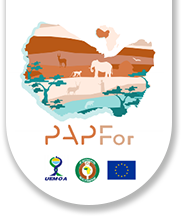Home / News / Establishing co-management committees for effective conservation of East (...)
Establishing co-management committees for effective conservation of East Nimba Nature Reserve, Liberia
Mount Nimba is a transboundary forest mountain ridge stretching from northeastern Liberia into southeastern Guinea and western Cote d’lvoire, with an altitude of about 1 752 m, making it one of the highest elevated forest ecosystems in West Africa. The magnificent mountain is home to amazing species of plants and animals, some of which are threatened and endemic to the mountainous landscape, including the Nimba flycatcher (Melaenornis annamarulae), Nimba toad (Nimbaphrynoides occidentalis) and the Nimba otter shrew (Micropotamogale lamottei). Mount Nimba is also an important source for rivers including the Saint John and Cavalla rivers, making it essential to the regional water cycle.
Over the years, communities living around national parks and nature reserves such as the East Nimba Nature Reserve (ENNR) in Liberia have been forbidden by law from entering the protected areas. Nevertheless, some continued to farm within the reserve, and extract minerals, logs, wildlife and other natural resources for their livelihood. This led to conflicts between communities and protected area authorities.
To address the issue, which is common to protected areas in many regions, communities have been allowed to enter the reserve to undertake livelihood activities that help to conserve natural resources and biodiversity, such as forest landscape restoration with cash crops and sustainable harvesting of non-timber forest products (NTFPs), such as rattan, local herbs and fruits, as proper extraction of these resources does not harm the protected area.
However, maintaining community rights to access resources in protected areas needs to be carefully managed, as communities depend on these resources. And communities need to take responsibility for the sustainable management to ensure continuous availability for future generations.
To pull off this balancing act, the European Union’s Support Programme for the Preservation of Forest Ecosystems in West Africa (PAPFor) is assisting East Nimba communities and the Forestry Development Authority (FDA) of Liberia to adopt co-management principles and values to effectively manage the reserve. Thus, PAPFor’s implementing partner in the Mount Nimba landscape, United Nations Office for Project Services (UNOPS), is helping communities identify and improve on traditional practices that are in line with the protection of the reserve.
Communities are encouraged to develop mutual management guidelines as part of the co-management plan wherein both parties see their critical roles in protecting the reserve. The co-management agreements are being drawn up between the Liberian government and the communities of Zor and Gba. As part of the agreement, the co-management committees (CMCs) and FDA conduct law enforcement patrols, bio-monitoring research and awareness raising on the importance of the reserve and the consequences of engaging in illegal activities such as mining, hunting and logging. CMCs are also responsible for mobilising communities to make the reserve’s boundaries clear.
In September 2010, the FDA and the Joint Forest Management Committee (JFMC) signed an agreement to co-manage ENNR forming the CMC, making them an integral part of managing the reserve. Over the years, communities around the reserve have set up co-management committees (CMCs) and are required to offer ideas for the establishment of the PAPFor-supported ENNR management plan. With support from PAPFor, these CMCs will be trained in the coming months to actively participate in the implementation of the plan.
In the light of the above, PAPFor through UNOPS will support local stakeholder consultation meetings to improve coordination between authorities and non-governmental organisations (NGOs) working in and around ENNR. According to Wellington Y-Tuo, a member of the CMC in Zorpata, the idea to co-manage the reserve is welcome. “The CMC is working tirelessly to increase awareness on the importance of ENNR and the benefits communities will derive from working closely with the FDA,” he said. He emphasised the need for CMCs to be trained in using GPS and computers to be able to monitor data stored. “The co-management plan should capture the provision of monthly stipends for the CMCs to be able to freely move about communities around the reserve,” he added.
“Incidences involving poachers from Guinea coming over to hunt in Blei community forest bordering Zor community forest in Liberia have been recorded. We met with the (Guinean) Centre de Gestion de I’Environnement des Monts Nimba and Simandou (CEGENS) in 2017 to investigate cross-border poaching and see how best we can put an end to it. Since the meeting, four poachers were arrested by rangers in 2021. The individuals were prosecuted and sent back to Guinea,” Wellington Y-Tuo said.
The EU-PAPFor project in ENNR will provide support to communities that identify and establish tourist sites for income generation. The project will also strengthen the capacity of CMCs to use GPS and train them to assess threats such as fire and hunting. The project will also support the finalisation of the ENNR management plan, and train FDA rangers and staff in ‘SMART’ data collection and park management. Consultative meetings with local stakeholders will be supported to effectively coordinate with local authorities and NGOs in finalising the reserve’s management plan. “Without the management plan, it is like operating without a constitution,” said Grace Kote-Zaasi, FDA biologist for East Nimba Nature Reserve.


